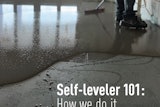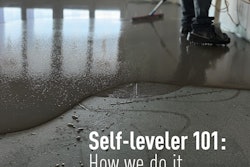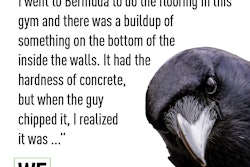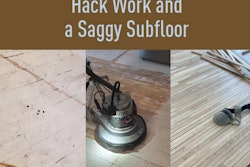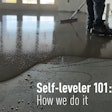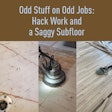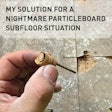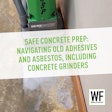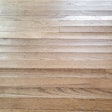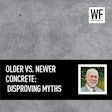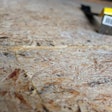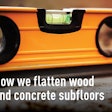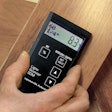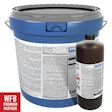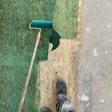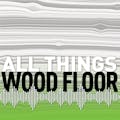
They can be dirty, musty and smelly. Sometimes they're disgusting and moldy. Occasionally they're even unhealthy. Removing them can be labor-intensive and dangerous. These all are good reasons why many wood flooring contractors avoid having anything to do with existing floor coverings.
Telling clients that their old floor coverings have to be removed before you install your wood flooring can be the easiest, smartest thing you can do. Other times you may decide that removing the carpeting, vinyl, linoleum or other flooring for the client is the best choice. Either way, you need a good awareness of those products, how they were installed and how they might affect your wood flooring job. The more you know, the more you can steer clear of the many pitfalls lurking in this type of remodel work.
Potential Pitfall
Any time you walk into a home to bid on a refinish of covered wood flooring or installation of new wood flooring in an existing home, the first step is to figure out what exactly is on the floor. Sometimes this can be as simple as tugging up a corner of the carpeting in a closet to reveal a beautiful wood floor underneath. That's the ideal scenario, but usually it isn't quite so easy. Floors may have multiple layers that form a veritable time capsule of floor covering history.
Keep in mind the asbestos risk posed by many of the old resilient floor coverings.
If you are bidding a resand and refinish of an existing wood floor underneath vinyl, linoleum or other floor covering, keep in mind the asbestos risk posed by many of the old resilient floor coverings, including some vinyl composition tile, vinyl tile and sheet, linoleum tile and sheet, and rubber tile and sheet. Depending on the product and its age, asbestos may be present in the product itself, its backing or in the adhesive used to install it. There is no easy way to identify whether the product contains asbestos or not. According to the guidelines for resilient floor covering removal from the Resilient Floor Covering Institute, "unless positively certain that the product you intend to remove is a non-asbestos-containing material, you must presume it contains asbestos." Government regulations may require that a sample be tested; the EPA recommends this be done by a professional (for links to more information about asbestos, see the sidebar "Asbestos Info").
If there is any possibility that the flooring contains asbestos, the best solution is to simply leave it in place and lay a new floor over it. Asbestos usually poses no risk unless it is disturbed, allowing the particles to become airborne.
Over the Top
Laying directly over vinyl and linoleum may be the easiest option, regardless of whether there is asbestos present in the floor or not. If this is the case, consider which types of wood flooring products are suitable. If there is an appropriate subfloor underneath and the flooring is securely glued, solid wood floors can be nailed directly on top. However, oftentimes these products (and carpeting) are installed over particleboard. In that case, the particleboard must be removed, or a suitable subfloor must be installed on top of it. Especially in kitchens, this may cause a height problem with the dishwasher and cabinets, leaving thinner wood flooring products—both glue down and nail- or staple-down—as the only option. Thinner glue-down products often can be installed over multiple layers of existing flooring; nail- or staple-down products usually can go over only one layer, since existing flooring materials don't hold the fastener, essentially becoming a "spacer." Refer to the specific manufacturer's recommendations when installing engineered products in these situations.
When vinyl and linoleum are glued over concrete and you intend to glue a wood floor on top of them, remember that the integrity of your wood floor will only be as good as the integrity of the original flooring job. If the original flooring wasn't glued securely, your wood flooring won't be securely attached to the floor, either. And, don't forget that there are a lot of perimeter-glued products still in use. In these situations (and when you are certain there is no asbestos risk), it's usually best to take the floor up and start with the slab. Most commonly, contractors use a razor bar to help shave the flooring off the concrete and then use a buffer to help remove all the glue from the slab. For large-scale projects, various machines—typically available at equipment rental shops—are available to do the job. Don't forget to test for adhesion after you think the slab is ready.
RELATED: A Guide to Subfloors Used Under Wood Flooring
In all these cases, remember the basic guidelines for subfloors—they must be dry, clean and flat. Just because a vinyl floor may have been installed over a floor with hollow spots and high spots doesn't mean it's acceptable for a new wood floor. Follow the manufacturer's recommendations and the NWFA's Installation Guidelines at all times.
Leaving a Trace
Many beautiful wood floors have been hidden for decades under layers of well-intentioned remodeling projects. More than ever, homeowners want to peel the layers back to these wood floors, helping restore the original character of their homes. Usually, the easiest situation is when the floors are covered by carpeting. If the carpeting was stapled down, it usually can be pulled up; just be sure that all the staples come out and that the tack strips with their large fasteners also come up. It's usually easiest to cut the carpet into strips; but be careful not to cut into the wood floor with the carpet knife or utility knife—those scratches probably won't come out. If you find or create scratches, they'll probably need to be hand-scraped before sanding. Carpeting that was glued also can be pulled up, and all remnants of the adhesive can be sanded off. Be aware that if the carpeting has signs of water damage or pet stains, those stains have likely penetrated down into the wood floor. Such stains may not come out, even after sanding, so spot replacement of those boards may be necessary.
When working with old carpeting, be aware of the threat posed by mold and mildew. If you find mold on the carpeting, consult an indoor air quality consultant to assess what should be done. Simply continuing to rip up the old carpeting could send potential toxins airborne.
Wood floors that were covered with other types of floors, such as tile, slate, vinyl and linoleum, may still show traces of the adhesives or mortar used to install them, even after the wood floors are thoroughly sanded. In these cases, it is the judgment call of the homeowners—some may like the wood floors, seeing the glue patterns as part of the history of the floor, and others may hate them, demanding that the floors be pulled up and replaced with similar new ones. Be aware of this contingency before you commit to the job, and if necessary, think creatively—these floors lend themselves to the hand-scraped and distressed finishes that are currently popular.
The Unknowns
There are other things to be cautious about when looking to resand and refinish these old floors. Perhaps you pulled up one inconspicuous area of the old floor covering and sanded and finished a sample area of the wood floor to show the customer how it might look. Finding it acceptable, you could commit to the whole job, not realizing that the old wood floor has an enormous water stain on the other side of the room.
In other cases, you may visually inspect the wood floor, which appears to be in good condition, but not realize that underneath, the subfloor is rotting away, making it nearly impossible to do an acceptable sanding job.
These are just two of myriad examples that can happen when you start unearthing old floor coverings to install or resand wood floors. Smart contractors who agree to do these types of floors usually include an "unseen conditions clause" in their contracts. This clause allows them to turn to plans A, B, C or more depending on what they discover along the way. Unit prices assigned to different tasks, such as floor covering removal, helps ensure they get paid for any labor they perform, even if they can't continue with the job as they expected. The point is to prepare for every scenario and to prepare the homeowner, as well. Above all, keep you, your customers and your business safe in the process.
Asbestos Info
For more information on the risks posed by asbestos and its removal, take a look at these Web sites:
- Environmental Protection Agency: www.epa.gov/asbestos
- Occupational Safety and Health Administration: www.osha.gov/SLTC/asbestos/
- Resilient Floor Covering Institute: www.rfci.com (click on “Removal of Existing Resilient Flooring Materials”).
Flooring samples should be sent to an EPA-approved laboratory for analysis. The National Institute for Standards and Technology (NIST) has a list of these laboratories. You can get this list from the Laboratory Accreditation Administration, NIST, Gaithersburg, MD 20899, telephone: 301/975-4016. Your state or local health department also may be able to help.










